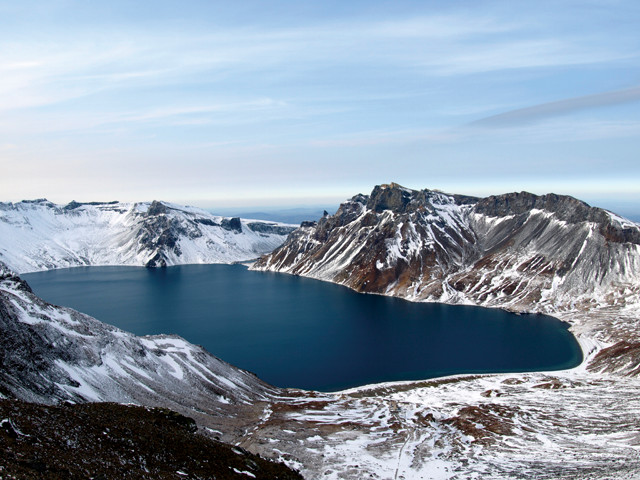
by Elizabeth Goldbaum Wednesday, July 20, 2016

Lake Chon fills part of Mount Paektu's caldera on the border of China and North Korea. Credit: James Hammond.
An enigmatic volcano straddling the border between North Korea and China has been investigated for the first time by an international team of seismologists. In 2013, researchers installed seismometers near the volcano — called Mount Paektu in North Korea and Changbaishan in China — to determine what was going on beneath the surface. The team’s results, detailed in a new study published in Science Advances, reveal a potential source of magma that may have created one of the largest volcanic eruptions in the last few thousand years — and that could cause the volcano to erupt again.
Picturesque Paektu — the name translates to “perpetually white mountain” in both Korean and Chinese — is “a very special volcano to the North Koreans,” appearing in iconic imagery and featuring in their national anthem, says James Hammond, a geophysicist at Birkbeck, University of London in England and one of the leaders of the team, which includes scientists from the U.K., the U.S., North Korea and China. The volcano has been active for 3.5 million years and is the site of the A.D. 946 “Millennium Eruption,” one of the largest historically recorded volcanic eruptions. The volcano had been relatively quiet until 2002 — when a series of small earthquakes (magnitude 3 or less) began rumbling through the region, lasting about three years — and has been quiet again since.
How the volcano formed in the first place is puzzling because it’s far from plate boundaries and other volcanoes. Some researchers suggest Mount Paektu is fed by a magma hot spot, while others suggest it is linked to tectonic activity 600 kilometers below the surface, where the Pacific Plate is slowly sinking beneath the Eurasian Plate.
Understanding the magmatic plumbing system beneath the volcano and how it relates to local earthquakes and mantle dynamics is important, says Cynthia Ebinger, a geophysicist at the University of Rochester in New York who was not involved with the study. The new findings provide a baseline measurement for determining potential hazards there, she says.
In 2013, the team installed six seismometers up to 60 kilometers east of the volcano’s rim in North Korea, as well as two stations closer to the volcano in China. “If you put a station in North Korea under the volcano, we can look at the structure within the crust and that gives us a glimpse of the inside of the volcano,” Hammond says. After analyzing the seismic data, the researchers identified a “mushy zone” of partially melted magma at least 20 kilometers across and “penetrating from the surface, or near the surface, down all the way through the crust” to a depth of about 40 kilometers, Hammond says.
“You expect to see regions of partial melt near volcanoes, so the fact that they found partial melt isn’t surprising by itself,” says Amanda Lough, a researcher at the Carnegie Institution for Science in Washington, D.C., who was not involved with the study. The work is important because it’s the first of its kind for this volcano, and “it’s always important to identify [magma] source regions,” Lough says.
Researchers are also geochemically analyzing rocks formed during the Millennium Eruption, Hammond says. Inside the rocks are chemical fingerprints of conditions in the magma chamber just before the volcano erupted, shedding light on the temperature and depth of the magma prior to eruption, which helps identify clues to look for before future eruptions, Hammond says.
The researchers plan to continue working to unravel Paektu’s past and help forecast its future. “It’s great to see that we’re able to work across political boundaries, particularly in areas that in the past have been very dangerous and that potentially in the future could be again,” Ebinger says.
© 2008-2021. All rights reserved. Any copying, redistribution or retransmission of any of the contents of this service without the expressed written permission of the American Geosciences Institute is expressly prohibited. Click here for all copyright requests.